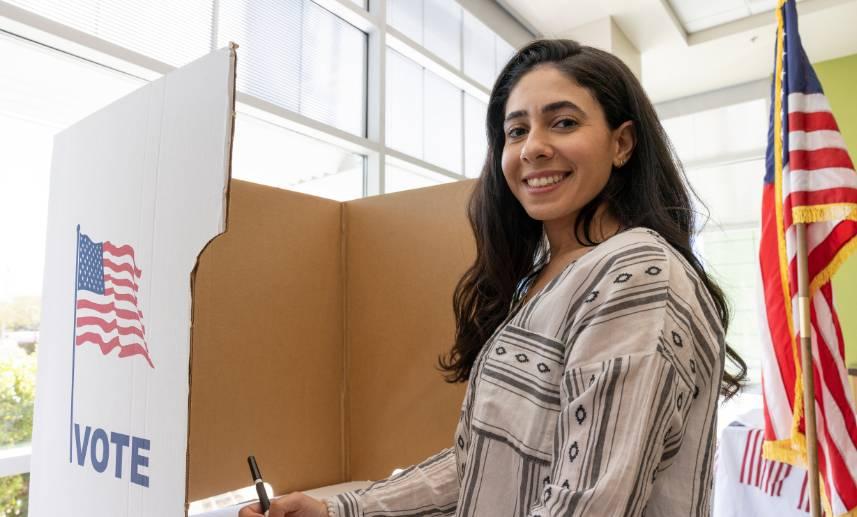On August 18th marks the 103rd anniversary of the 19th Amendment to the United States Constitution, which recognized women’s right to vote. This historic milestone honors the legacy of the fight for women’s suffrage, gender equality, and women’s political participation overall. It is also an opportunity to reflect on the current impact of Latina women’s votes in the country.
The journey towards women’s suffrage in the United States has been marked by struggle, tireless work, and sacrifice from prominent activists like Sojourner Truth, Elizabeth Cady Stanton, Lucretia Mott, and Susan B. Anthony, who are living embodiments of the suffrage movement.
The path to women’s suffrage had pivotal moments that led to the achievement of the 19th Amendment in 1920. The Seneca Falls Convention in 1848 marked the beginning of the battle for women’s voting rights, and from then on, various organizations led by activists emerged across the U.S.
However, it is worth noting that while the amendment granted women the right to vote, it did not address the discrimination faced by women of color. It wasn’t until 1967 that women of color were able to exercise their right to vote in the U.S., after a tough struggle that culminated with the Civil Rights Act and the Voting Rights Act.
The Power of Latina Women’s Votes in Elections
Today, the women’s vote, particularly that of Latina women, has a significant impact on U.S. presidential elections. According to the Pew Research Center, in 2021, there were approximately 62.5 million Hispanics in the U.S., representing about 19% of the total population. Four out of five Hispanics/Latinos are citizens, giving them the ability to exercise their voting rights.
The activism of Latina women in exercising their right to vote is noteworthy. Contemporary voices like María Teresa Kumar and Julissa Arce promote women’s political participation and suffrage.
According to a 2016 CUNY/CNN study, Hispanic women voted in greater proportions than men in all presidential elections between 1992 and 2012, with voter participation ranging from 53% to 55% of total Hispanic voters. Additionally, Latina women register and vote in larger numbers than Hispanic men, with a 3 percent point difference in both cases between 1992 and 2012, according to the Institute for Women’s Policy Research.
Priority Issues for Latina Women
Priority issues for Latina women in the U.S. encompass a wide range of concerns. These include immigration, education, access to healthcare, gender equality, childcare, safety and justice, economic equality, and the environment. These issues are affected by gender bias, racism, intersectional discrimination, and other factors that influence women’s voting and its impact on politics.
It is crucial for Latina women to be involved and actively participate in the political process. There are many ways to do so, such as getting digitally active, educating oneself about the Sustainable Development Goals, attending workshops and political events, leading dialogues, promoting diversity and inclusion, and volunteering for campaigns that support their interests.
Honoring and valuing the work of Latina women in political spaces is another way to encourage their participation. Following prominent figures like Verónica Escobar, Lucille Roybal-Allard, Nydia Velázquez, and Alexandria Ocasio-Cortez contributes to highlighting their work and opening opportunities for more women in politics.
How Can You Help More People Exercise Their Right to Vote?
You get involved and participate by learning about current movements and actions within your reach. Here are some that you can delve into further and choose from:
- Get digitally active. Use movements like #HeForShe as reference and find digital movements that resonate with you.
- Educate yourself. Learn more about the 2030 Agenda and its 17 Sustainable Development Goals (SDGs), with one of its primary goals being gender equality and women’s empowerment.
- Seek. Attend workshops, talks, and events that address the electoral processes in your community.
- Join. Locate awareness campaigns in your community about the importance of voting and how it can influence policies that affect you.
- Organize. Lead dialogue spaces with people you know, forums, book clubs, and more. Remember to create spaces for those with young children to attend.
- Plant. If you’re in a position to provide or receive mentorship, do it. Fostering leadership among Latina women has far-reaching significance.
- Speak up. Get involved in issues you consider relevant to your own well-being, your family and community. When spreading information, make sure it is verified.
- Promote. Be an advocate for diversity and inclusion. Support Latina candidates for public office and help them connect with policies addressing the most urgent needs of the Latina community.
- Update yourself. Learn new technological skills to reach more women, especially from generations different from your own.
- Stay informed. In the U.S., the minimum voting age is 18. Register to vote, research the candidates, and aim for an informed vote.
- Volunteer. You can volunteer for political campaigns of candidates who support and represent your interests.
The vote of Latina women is a powerful instrument of change and political participation in the United States. While significant achievements have been made since the Seneca Falls Declaration, it is important to continue working for women’s political rights and to remember that every small effort counts towards building a more inclusive and representative society.
Women’s political participation is essential for strengthening democracy and promoting gender equality in the nation.
